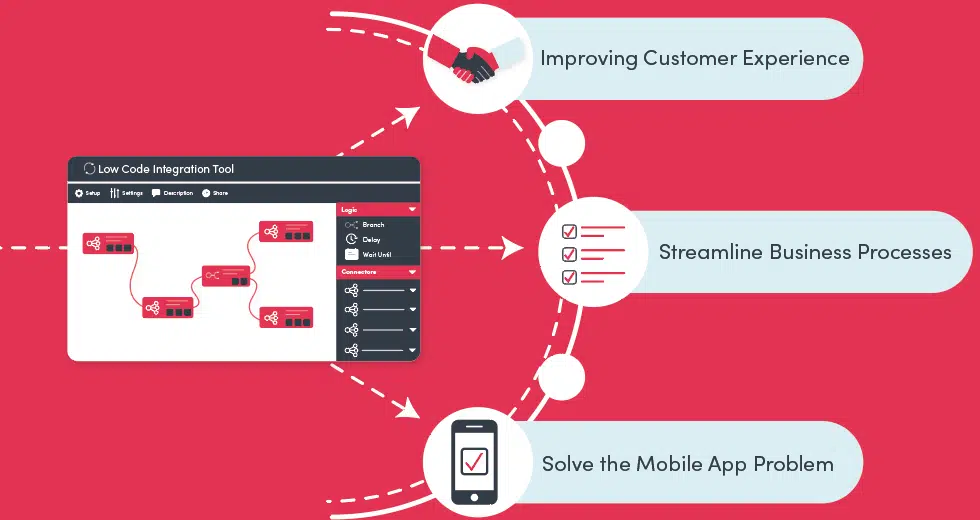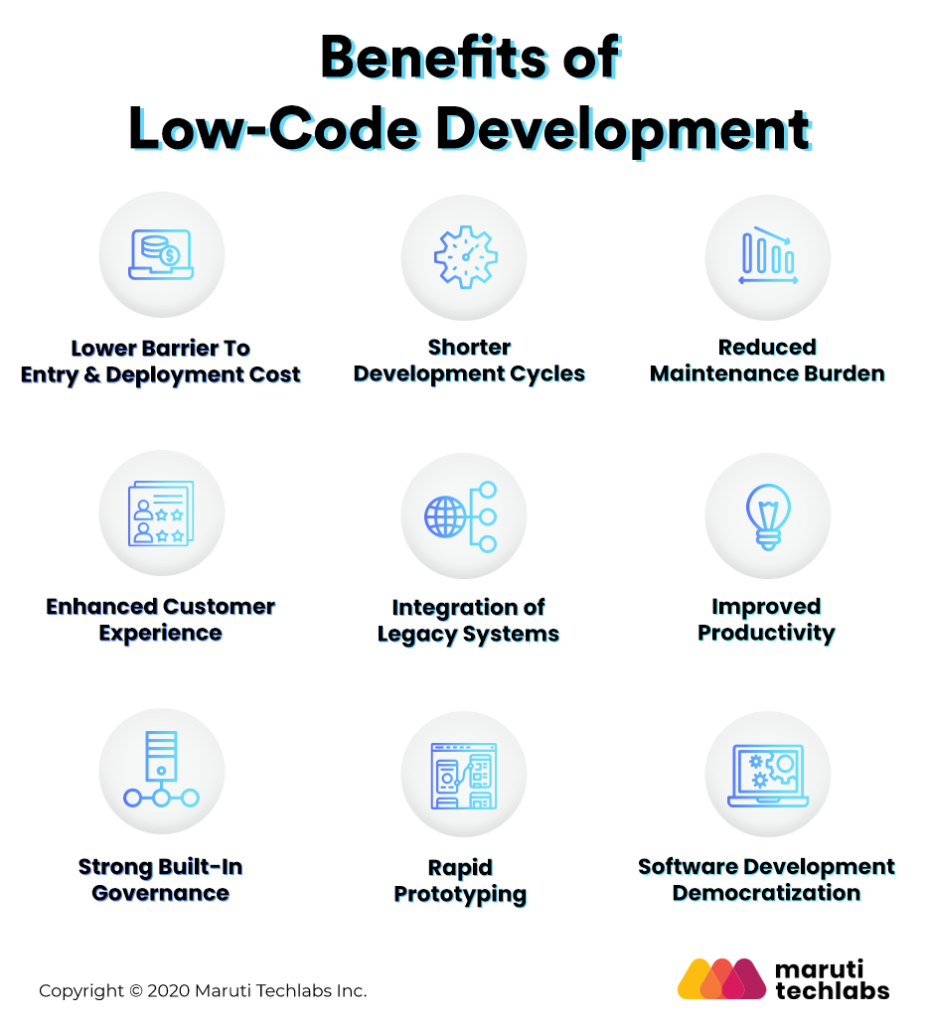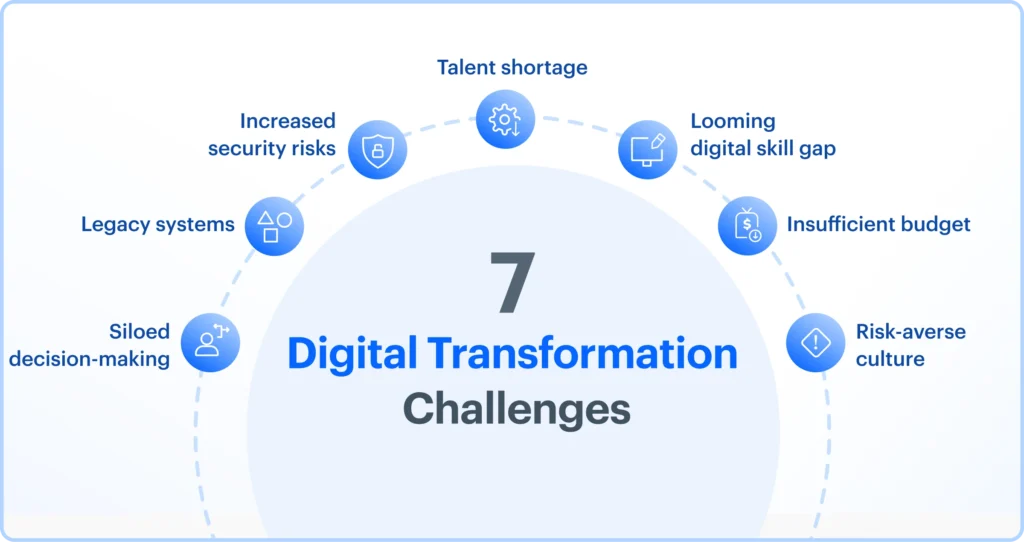
The Low Code Approach to Digital Transformation
Low-code digital transformation relies leverages intuitive visual interfaces and pre-built components to streamline product/app creation. Unlike traditional methods reliant on extensive coding expertise, these platforms democratize development, enabling teams with varying technical backgrounds to contribute effectively. This accessibility not only accelerates development cycles but also enhances collaboration across multidisciplinary teams and brings about easier, faster digital transformation.

The strategic adoption of low-code platforms is pivotal for CTOs aiming to accelerate time-to-market, enhance business agility, and foster seamless collaboration across teams. This article explores how low-code solutions empower IT leaders to drive innovation and accelerate digital transformation strategies.
The role of low code in digital transformation
Amidst the relentless pace of digital transformation, CTOs are increasingly turning to low-code platforms as a strategic imperative to propel their organizations forward. These platforms represent more than just a technological evolution – they serve as catalysts for innovation, agility, and efficiency across industries.

Traditional software development processes often struggle with lengthy cycles that can span months from initial concept to deployment. Low-code platforms transform this landscape by enabling rapid prototyping and development. According to Forrester, organizations leveraging low-code development achieve up to 10 times faster application delivery compared to traditional methods. This acceleration is not merely about speed but also about capturing market opportunities swiftly, thereby gaining a competitive edge.
By reducing time-to-market, CTOs can align technology initiatives more closely with business needs and market demands. This agility allows for quicker adaptation to changing customer preferences and industry trends, translating into enhanced revenue generation and customer satisfaction.
Implementing low-code platforms can yield substantial cost savings. Organizations report up to 50% reduction in development costs due to accelerated delivery times and reduced reliance on specialized development resources. Moreover, faster time-to-market translates into earlier revenue generation and competitive advantage.
Key benefits of low code platforms in your tech stack
Accelerated time to market flexibility
In a competitive environment, business agility is a hallmark of successful organizations. Low-code platforms empower CTOs to respond promptly to evolving business needs through iterative development and rapidly shorter time to market.

Industries such as finance and retail benefit significantly from this capability, where the ability to pivot quickly in response to market shifts directly influences market share and customer loyalty.
CTOs gain the strategic advantage of steering their organizations through digital transformation with confidence. By leveraging low-code platforms, they can lead initiatives that drive innovation and responsiveness, positioning their companies as industry leaders in agility and customer-centricity.
Enhancing collaboration across teams
Effective collaboration is fundamental to the success of digital initiatives. Low-code platforms facilitate collaboration by offering intuitive visual interfaces that bridge the gap between technical and non-technical teams. This approach fosters a shared understanding of project goals and requirements, promoting cross-functional alignment and innovation. By streamlining communication and workflow processes, CTOs can nurture a culture of collaboration that accelerates development cycles and maximizes resource efficiency.
Improved collaboration translates into accelerated project delivery and reduces operational silos. CTOs can optimize resource allocation and talent utilization, ensuring that teams work cohesively towards achieving strategic objectives. This collaborative framework not only enhances productivity but also cultivates a culture of continuous improvement and innovation within the organization.
Streamlining application life cycle management with low-code development
Low-code development stands at the forefront of this evolution, promising organizations the ability to produce applications that are not only rapid but also flexible and cost-effective. By minimizing traditional coding complexities, low-code empowers businesses to deploy applications with unprecedented speed and adaptability to future enhancements.

One of the standout features of low-code platforms is their capability to expedite application delivery without heavy reliance on traditional DevOps or engineering teams. By simplifying the development process, these platforms enable users to deploy applications with just a few clicks. This accelerated deployment cycle not only enhances operational efficiency but also positions organizations to respond promptly to market demands and customer expectations.
Low-code platforms streamline the entire application life cycle—from development and deployment to monitoring, maintenance, and updates—through a unified, real-time interface. This holistic approach ensures robust security measures, regulatory compliance, and seamless version control throughout every stage of the application’s life span.
At the core of low-code development lies its promise of reduced complexity in application maintenance. With fewer lines of code to manage, organizations benefit from streamlined maintenance processes, allowing them to swiftly implement changes and updates as required. This efficiency not only preserves the application’s relevance and functionality but also minimizes operational disruptions and downtime.
Integrating AI and IoT with low code tech
Looking ahead, the convergence of AI, data analytics, and IoT will showcase the power of low-code platforms in driving digital transformation.
- AI-driven capabilities, such as natural language processing and predictive analytics, will:
- Automate development processes
- Enhance user experience and engagement
- The expansion of IoT devices will lead to:
- Large-scale data collection, storage, and analysis
- Low-code platforms enabling automated data processing and delivering valuable insights
- Advanced analytics features in low-code platforms will:
- Simplify application development
- Empower real-time decision-making, placing organizations at the forefront of technological innovation.
Challenges in low code digital transformation
However, despite its benefits, low-code adoption in digital transformation may face challenges such as integration complexities, security concerns, and resistance to change. A loose skeleton framework of network security is built into these programs, yes. But if companies without data scientists or cybersecurity professionals implement these solutions, data security and network security holes may plague orgs. When using a low code framework, CTOs need to ensure security through robust governance frameworks, cybersecurity protocols, and organizational change management strategies is crucial for successful implementation.

Extensibility and customization
While low-code platforms provide pre-built components for rapid development, they also support extensibility through custom code integration. This flexibility allows CTOs to incorporate complex business logic or integrate with existing systems seamlessly, adapting applications to specific organizational requirements.
Ensuring scalability and performance is critical for enterprise-grade applications. Low-code platforms leverage cloud-native architecture and built-in scalability features to support growing user bases and increasing data loads. This scalability is complemented by robust performance metrics, ensuring applications meet high standards of reliability and responsiveness.
Low-code platforms facilitate innovation by lowering the barrier to entry for experimentation and proof of concepts (POCs). CTOs can test new ideas quickly, iterate based on user feedback, and pivot strategies with minimal risk. This agility fosters a culture of innovation, driving continuous improvement and differentiation in the marketplace.
In brief
The adoption of low-code platforms marks a strategic shift in how CTOs approach digital transformation. By embracing these platforms, CTOs can expedite application development, enhance agility, and foster innovation across their organizations. As technology continues to evolve, leveraging low-code solutions empowers CTOs in driving sustainable growth and competitive advantage in the digital era.